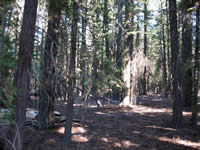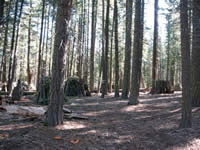
National Fire Plan Success Story
Lost Creek and Crags Campground Fuel Reduction Project
Lassen Volcanic National Park, California
National Fire Plan - Fuels Reduction

Eastern boundary of the project before hazardous fuels were removed.

Eastern boundary of the completed project showing removed and piled fuels to be burned during the winter.
During the 2006 season, a contract crew completed an extensive hazard fuel reduction and thinning project in the developed areas of Lost Creek and Crags Campground in Lassen Volcanic National Park. The project removed hazard fuel loads as well as an overabundance of white fir trees. The unnaturally dense stands were creating a high fire hazard and posing a threat to forest health.
Historically, ponderosa and Jeffrey pine were the dominant vegetation types in the campgrounds. With the absence of fire, hazardous fuel loading increased and white fir slowly took over the area. The increased fuel loading and high density of white fir trees lead to an increase risk of crown fire and diseases such as annosus (green tree failure) and amillaria (root disease), making the campgrounds unsafe for visitors and a detriment to forest health.
The project included removing white fir trees with a diameter of 18 inches or less within five feet of the canopy drip line of all large pine (more than 20 inches diameter breast height [dbh]), and from within three feet of the canopy drip line of smaller pines. All dead surface fuel greater than 3 inches in diameter and slash created from the thinning project was removed, piled or stacked for burning. Stumps were cut flush to the ground and treated with Sporax to prevent fungal attack. Trees identified with root disease or other major defects were removed. Approximately 75% of the total stand density was removed inside the 40- acre boundary of the two campgrounds.
Under story and ladder fuels have been removed to eliminate the high fire hazard. The growth rate and vigor of the remaining trees should steadily improve. In phase three, ponderosa and Jeffrey pine will be planted to help enhance the natural regeneration process.
Contact:
Jon Arnold, Park Forester
Phone: (530) 595-4444 ext. 5171
Eric Hensel, Fire Management Officer
Phone: (530) 595-4444 ext. 5168